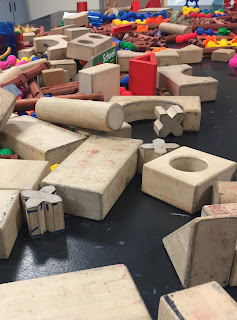Making PD Happen
 A few weeks ago, I was privileged to attend a workshop on Makerspaces sponsored by Verizon Innovative Learning and facilitated by MakerEd. In the same general time frame, I was planning my first major event as a Technology Integration Collaborator. As I began planning the event (our beginning of the year Boot Camp for teachers in our tech cadre called ITECS), I planned a series of activities meant to focus on the larger picture of why we teach with technology as well as drilling down into some best practices of edtech and the finer details of our specific program.
A few weeks ago, I was privileged to attend a workshop on Makerspaces sponsored by Verizon Innovative Learning and facilitated by MakerEd. In the same general time frame, I was planning my first major event as a Technology Integration Collaborator. As I began planning the event (our beginning of the year Boot Camp for teachers in our tech cadre called ITECS), I planned a series of activities meant to focus on the larger picture of why we teach with technology as well as drilling down into some best practices of edtech and the finer details of our specific program.
When I had a completed agenda of the day, I realized that I had created an event that definitely skewed toward the maker mindset (I wasn’t too upset about that!) Based on responses, participants enjoyed it as well!
These were some of the activities:
What does technology create in your classroom? (answer with playdough, take pic and add to collaborative slideshow with explanation)
Create an ideal process for implementing a new tech tool into your classroom (illustrate with flow chart)
What is your purpose as a participant in this program? (write, draw, create, etc.)
Design your logo for a business card you could hand out as a member of ITECS (in Canva)
Looking back at my makerspace workshop notes, I realized that the maker mindset is very appropriate in adult learning as well. The three main tenets that I took away from the workshop were that one’s makerspace should focus on real learning, real engagement, and real life. As it turns out, these are great focus areas for teaching adults as well.
Real learning: We don’t want to waste people’s time with things they already know, so give them time to engage with material that is truly new (which might mean giving folks who come with a solid understanding of the given topic time and resources to delve deeper, and/or speaking separately with the poor soul with the deer in the headlights look 5 minutes in and giving them a limited set of concepts to work with, rather than the whole kit and caboodle.)
 Real engagement: Like students, just because teachers are looking at you and producing what you’re asking them to produce doesn’t mean they’re engaged. In the military, compliance is the requirement. In education though, we want people actually engaged and caring about the topic, not just complying to get through the day. The more teachers (and students) are given choice in what they work on, the better chance they’ll be truly engaged, so let go of a little control, and be amazed at the creativity you’ll find!
Real engagement: Like students, just because teachers are looking at you and producing what you’re asking them to produce doesn’t mean they’re engaged. In the military, compliance is the requirement. In education though, we want people actually engaged and caring about the topic, not just complying to get through the day. The more teachers (and students) are given choice in what they work on, the better chance they’ll be truly engaged, so let go of a little control, and be amazed at the creativity you’ll find!
Real life: Again, in the same way that students are more engaged when they are composing a letter a principal will actually see, (vs. “imagine you’re writing a letter to the principal”), adults are 1000% more engaged when they are working on something they can actually use. If participants are having a hard time identifying how they can use the given topic in their classroom setting, help them out. If there is legitimately no reason for them to use that topic, help them find a topic that will and let them work on that. Real life = real engagement!
So, in short, make it real!
How do you encourage folks in your sessions to make learning real? Have you implemented any maker-mindset concepts in your setting? Let me know in the comments!


Quality points there in "Real engagement." A related question I've been mulling over is: how do we motivate teachers who, when given freedom or choice, don't engage or want to be creative?
ReplyDeleteI'd ask the teachers what they are interested in, what's a topic that's sounded intriguing to them but they've never had time to research on their own. Or go all out and do an Edcamp! You'd be amazed what teachers will talk about on a professional level when given the opportunity.
Delete